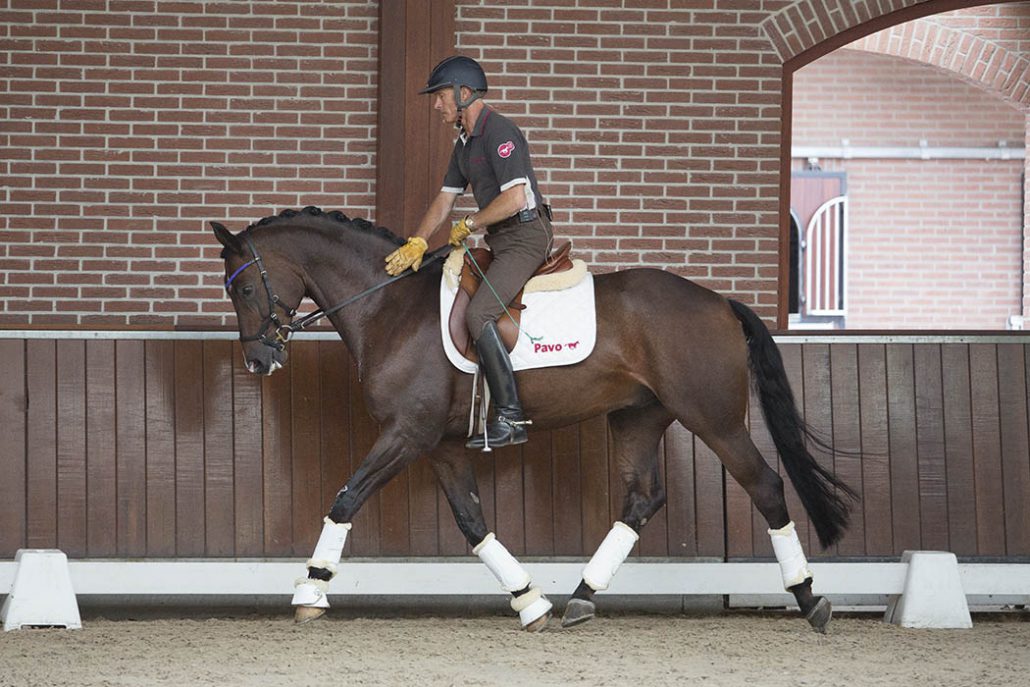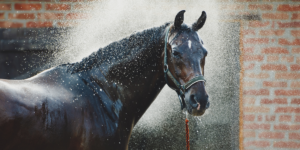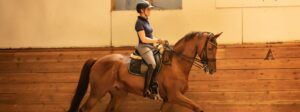The thing most riders forget about: the contact rein
In all the years he has been teaching riders from all around the world, Rien van der Schaft noticed that the core of 99% of all of the problems riders deal with spiral down to one aspect in the training.
According to Rien, it’s the thing most riders forget about or don’t do correctly: getting the right connection by riding with the contact rein.
Rien explains:
It’s the first phase we go through when we start riding our horses and an essential phase if you want to have the training fundamentals in place.
Basically what you want to achieve in this phase is three things, namely relaxation, forwardness and that your horse accepts the contact.
And to be more precise, not only that your horse accepts the contact, but that he finds the contact pleasant.
I call this phase the contact rein.
Ride the horse forward to the bridle and do not care about the head-neck position until your horse accepts the bit and wants to stay in contact with the rider’s hand.
You want to achieve relaxation, forwardness and that your horse accepts the contact.
A lot of riders think their horse is forward, but actually it isn’t. Most of the times it’s something you find out when you progress in the training and you run into problems.
But even more so, the problem of the first phase has to do with the contact.
I believe you shouldn’t want to try to influence the head-neck position into a certain frame,
before the horse accepts the bridle and goes with that contact in his natural frame and balance.
Sooner than most riders think, when riding in a good way the horse will come into a right frame.
When a horse, instead, comes against the bit, he’s telling you he doesn’t like the contact and doesn’t trust your hand. He braces himself to prevent himself from getting hurt.
If you prevent your horse from coming against the bit, it might look better, but you don’t take away the reason why your behaves that way. You don’t solve the problem.
I advice riders to just follow the mouth of the horse the best they can.
Once your horse trusts your hand, he won’t come against the bit anymore. He will find the position that’s most comfortable for him.
That’s never a position where your horse moves with head up or with his nose to his chest.
And that makes sense. When you lunge your horse without any side reins, you will never see your horse moving with his head all the way up or too deep. He will most of the times move with his head in a forward-down direction.
So how long does this phase take?
Usually, it only takes a couple of days before your horse learns to trust your hand. You can see big improvements in a short amount of time.
However, I’ve also encountered horses where it took several weeks. I can assure you it didn’t look ‘professional’ when one is riding horses and follow their mouth while they kept their head up.
When the contact stays consistent and soft, the horse will trust the hand.
When the rider’s hand follows the movement of the horse’s head and the contact stays consistent and soft, soon the horse will trust the hand and likes to stay in touch with the hand. But you have to give your horse the time he needs.
And from there, you can start to capture the forwardness and redirect that into a more solid connection.
But you can’t take that step if your horse doesn’t trust your hand.
It will definitely lead to problems in the connection.
One should only resist the impulsion from behind with the hand if the horse accepts the contact and from that moment on we can call it ‘connection.’
So if you’re having problems with the connection, go to the phase of the contact rein and make sure you have it established before taking the next step. And it doesn’t matter if you’re riding Novice Level or Grand Prix, allow your horse to go through that phase.





5 Reacties
Hello Rien…congratulation for your web site..you remind me of my trainer also a dutchman who was the chief d’ equipe for Prince Bernhardt in the Netherlands. His name was Harry Scheerin. He migrated to Australia to teach and I was his pupil for many years. I still hear his voice..”you must ride your horse forward Michele into the bridle asking the horse to seek the bit through rein contact”. Thank you for pointing out this most important technique in dressage as it must be understood by the rider as the first fundamental step in training a horse to accept the bit and trust your hand.
Hello Rien. I am really enjoying what I have seen so far of your course however I haven’t seen any focus on the importance of the independent balanced (relaxed) position of the rider. This being so crucial for the horse to balance itself, go forwards happily , to trust the riders hand and seek the contact rein.
Hi Charlotte, thanks for your kind words. Which course are you talking about? I believe you’re not a member of Rien’s training ‘From Basics to Grand Prix’, right?
Thanks for this post and excellent description. Would love to try this with my mare. My problem is that she starts to speed up at times, which makes it very difficult for me not to use more reign than I wohl love to otherwise. Before I bought her she was ridden for show jumping purposes and schooled with a falsely bend neck.
Do you have any suggestions?
With kind regards